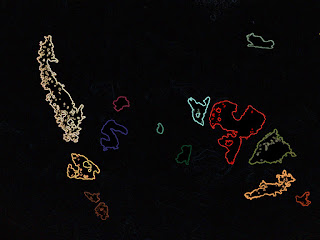For this wall, I just used different colors with the Paint Bucket, and most of the lines stayed colored this time when I applied the Glowing Edges filter.
Saturday, April 28, 2012
Saturday, April 21, 2012
"Unbreak My Heart"
Here's another picture I took in the shower (and you should know by now what I mean by that;)).
I thought the blob on the right looked like a broken heart, and I meant to just fill in that spot with the Paint Bucket tool, but then I thought, "Why stop there?"
I applied a Paint Bucket color, set to about 10 tolerance (I had to adjust a little occasionally to prevent bleeding), to every substantial patch of brown in the image. Then I applied the Glowing Edges filter, which outlined the contrasting colors like so.
Then I used the eyedropper (or Color Selection Tool) to sample a color from each of the outlines. After I sampled an outline color, I then used the Paint Bucket to apply it to the whole outline.
To create a bit of balance to the image, I got rid of the white dots in the upper right (which were outlines of water droplets in the original photograph), and replaced them with a warped copy of one of the blobs.
I thought the blob on the right looked like a broken heart, and I meant to just fill in that spot with the Paint Bucket tool, but then I thought, "Why stop there?"
I applied a Paint Bucket color, set to about 10 tolerance (I had to adjust a little occasionally to prevent bleeding), to every substantial patch of brown in the image. Then I applied the Glowing Edges filter, which outlined the contrasting colors like so.
Then I used the eyedropper (or Color Selection Tool) to sample a color from each of the outlines. After I sampled an outline color, I then used the Paint Bucket to apply it to the whole outline.
To create a bit of balance to the image, I got rid of the white dots in the upper right (which were outlines of water droplets in the original photograph), and replaced them with a warped copy of one of the blobs.
Labels:
Adobe Photoshop CS4,
artist,
blog,
blogging,
creative,
graphic,
graphic artist,
writing
Saturday, April 14, 2012
The Hunger Games: No Actual "Gladiator Ending"
I watched the "Hunger Games" last Monday, and I've read the entire book trilogy. The movie was pretty good on its own, yet there were a few moments that are best clarified on reading the books. Of course, the books' virtually always better than the movie, but certain elements, such as the issues between Katniss and her mother, and the bond with her costumedesigner/stylist are far too abbreviated in the movie.
One thing I liked about the "Hunger Games" is that even though it uses violence as a hook, it is not the end, merely the means of the storytelling. Yet at the same time, it doesn't hold back on what you would expect from an actual "fight to the death" game. One thing I found particularly gratifying is that there was none of what I call "gladiator moments". These are when the hero has the villain at his mercy, and awaits the "thumbs up, or thumbs down" from the scriptwriter, who nearly always gives the thumbs up, especially in a "family-friendly" film. I've grown to dislike these finishes because they are all too often not crucial to the plot, they just exist to show off how big-hearted the hero is. One example that I thought particularly bad was the one in "Prince Caspian" where Peter disarms Miraz, then hands the sword off to Caspian, thinking since Miraz killed Caspian's father, Caspian should have the right of dispatching him. But Caspian spares Miraz, because he doesn't want to be like Miraz. I thought they could've done without that scene, because it wasn't even in the book, and it looked like they just threw it in there to show off Caspian's goodness. In real life, how many people in the bad guy dispatching business (such as police, and soldiers) even have the opportunity for a "gladiator moment"? When you are fighting somebody trying to kill you, how often do you even get the chance to merely disarm them and have them at your mercy? From what I understand of the "suicide by cop" situation, when a person pulls a weapon, especially a gun, on a police officer, that officer is justified in shooting immediately. It stinks for the officer, but if they hesitate even an instant out of a desire for mercy, they risk getting shot first, and the shooter going on to shoot whoever else they please. In the "Hunger Games" neither the original author nor the movie scriptwriters didn't try to go for any big-hearted, spare the opponent moments. They had the players really fight, to the death, as you would expect people in that situation to do. Yes Katniss helps little Rue, and yes she and Peeta refuse to fight each other in the end, but all the opponents who want to actually kill them are fair game. It's not idealistic, but that's what makes the story so powerful.
One thing I liked about the "Hunger Games" is that even though it uses violence as a hook, it is not the end, merely the means of the storytelling. Yet at the same time, it doesn't hold back on what you would expect from an actual "fight to the death" game. One thing I found particularly gratifying is that there was none of what I call "gladiator moments". These are when the hero has the villain at his mercy, and awaits the "thumbs up, or thumbs down" from the scriptwriter, who nearly always gives the thumbs up, especially in a "family-friendly" film. I've grown to dislike these finishes because they are all too often not crucial to the plot, they just exist to show off how big-hearted the hero is. One example that I thought particularly bad was the one in "Prince Caspian" where Peter disarms Miraz, then hands the sword off to Caspian, thinking since Miraz killed Caspian's father, Caspian should have the right of dispatching him. But Caspian spares Miraz, because he doesn't want to be like Miraz. I thought they could've done without that scene, because it wasn't even in the book, and it looked like they just threw it in there to show off Caspian's goodness. In real life, how many people in the bad guy dispatching business (such as police, and soldiers) even have the opportunity for a "gladiator moment"? When you are fighting somebody trying to kill you, how often do you even get the chance to merely disarm them and have them at your mercy? From what I understand of the "suicide by cop" situation, when a person pulls a weapon, especially a gun, on a police officer, that officer is justified in shooting immediately. It stinks for the officer, but if they hesitate even an instant out of a desire for mercy, they risk getting shot first, and the shooter going on to shoot whoever else they please. In the "Hunger Games" neither the original author nor the movie scriptwriters didn't try to go for any big-hearted, spare the opponent moments. They had the players really fight, to the death, as you would expect people in that situation to do. Yes Katniss helps little Rue, and yes she and Peeta refuse to fight each other in the end, but all the opponents who want to actually kill them are fair game. It's not idealistic, but that's what makes the story so powerful.
Labels:
artist,
blog,
blogging,
creative,
graphic,
graphic artist,
Hunger Games,
violence,
writing
Saturday, April 7, 2012
Wall Faces
This is another picture from the shower. I decided to take a bit more minimal approach to bringing out what I saw in it.
This is the original, unaltered picture.
This is how the picture looked after I used the eyedropper tool to lift one of the colors, and fill out a man's head, eyes, mouth, and nose.
Since the outlines don't stand out that well, I gave it the "Ink Outlines" filter.
Subscribe to:
Posts (Atom)















